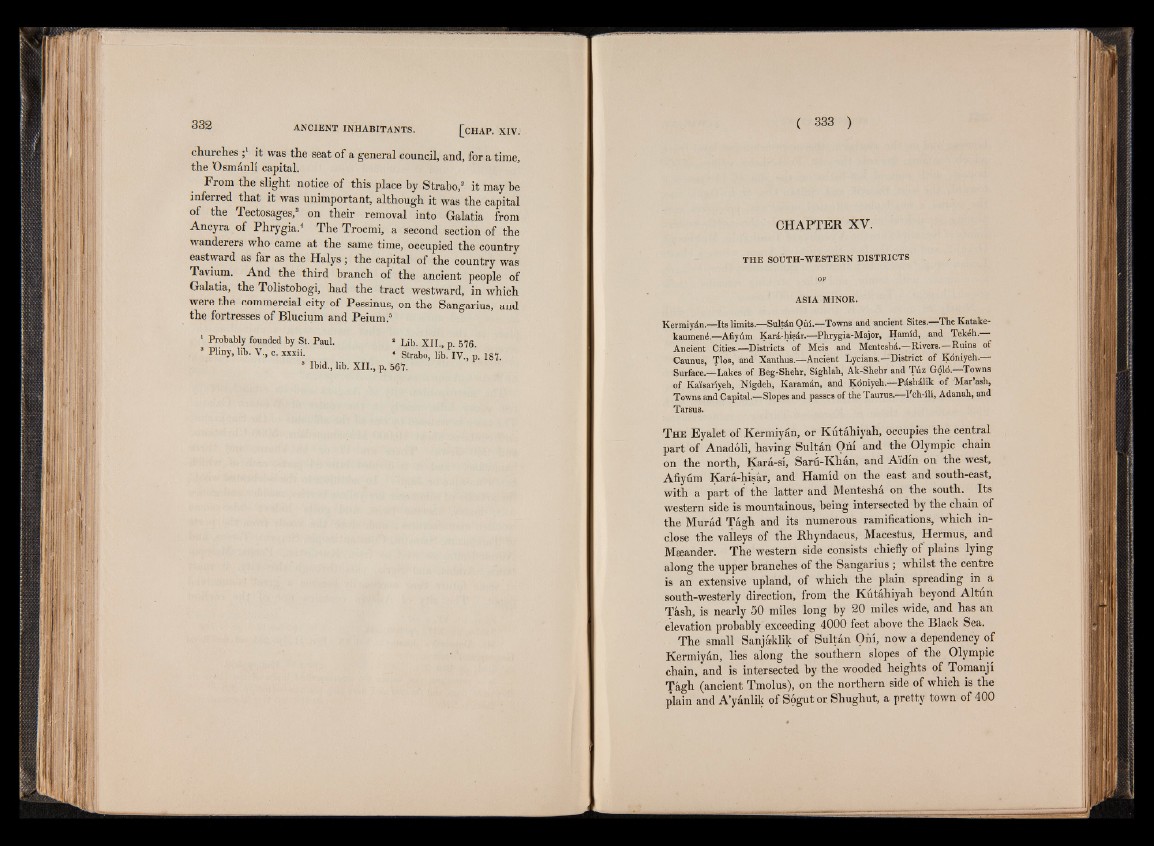
churches it was the seat of a general council, and, for a time,
the Osmanli capital.
From the slight notice of this place by Strabo,2 it may be
inferred that it was unimportant, although it was the capital
of the Tectosages,3 on their removal into Galatia from
Ancyra of Phrygia.4 The Trocmi, a second section of the
wanderers who came at the same time, occupied the country
eastward as far as the Halys ; the capital of the country was
Tavium. And the third branch of the ancient people of
Galatia, the Tolistobogi, had the tract westward, in which
were the commercial city of Pessinus, on the Sangarius, and
the fortresses of Blucium and Peium.5
1 Probably founded by St. Paul. a Lib. XII., p. 576.
3 Pliny, lib. V., c. xxxii. ‘ Strabo, lib. IV., p. 187
3 Ibid., lib. XII., p. 567.
CHAPTER XV.
THE SOUTH-WESTERN DISTRICTS
OF
ASIA MINOR.
Kermiyán.—Its limits.—Sultán Oñi.—Towns and ancient Sites.—The Katake-
kaumená.—Afiyúm Kará-hisár.—Phrygia-Major, Hamid, and Tekéh.
Ancient Cities.—Districts of Meis and Menteshá. Rivers. Ruins of
Caunus, Tlos, and Xanthus.—Ancient Lycians.—District of Kóniyeh.
Surface.—Lakes of Beg-Shehr, Sighlah, Ak-Shehr and Túz Góló.—Towns
of Kaísariyeh, Nigdeb, Karamán, and Kóniyeh.—Páshálik of Mar’ash,
Towns and Capital.—Slopes and passes of the Taurus.—I'ch-ili, Adanah, and
Tarsus.
T h e Eyalet of Kermiyán, or Kútáhiyah, occupies the central
part of Anadóli, having Sultán Oñí and the Olympic chain
on the north, Kará-sí, Sarú-Khan, and Aidm on the west,
Afiyúm Kará-hisár, and Hamid on the east and south-east,
with a part of the latter and Mentesha on the south. Its
western side is mountainous, being intersected by the chain of
the Murád Tágh and its numerous ramifications, which inclose
the valleys of the Rhyndacus, Macestus, Hermus, and
Meeander. The western side consists chiefly of plains lying
along the upper branches of the Sangarius ; whilst the centre
is an extensive upland, of which the plain spreading in a
south-westerly direction, from the Kutahiyah beyond Altun
Tásh, is nearly 50 miles long by 20 miles wide, and has an
elevation probably exceeding 4000 feet above the Black Sea.
The small Sanjáklik of Sultán Oñí, now a dependency of
Kermiyán, lies along the southern slopes of the Olympic
chain, and is intersected by the wooded heights of Tomanji
Tágh (ancient Tmolus), on the northern side of which is the
plain and A’yánlik of Sógut or Shughut, a pretty town of 400